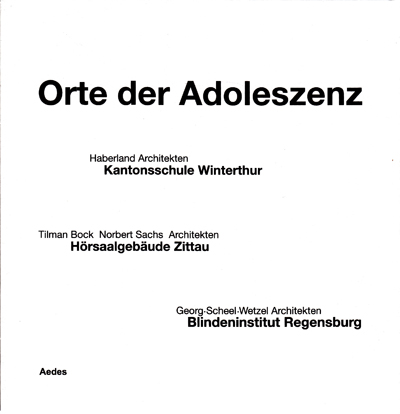Three places of growing up – the Institution for the Blind at Regensburg, the Cantonal School Rychenberg / Winterthur and the Lecture Hall, Zittau – three concepts for a school environment. A different framework determines the progam and the utilization of each respective building type. Realization of the projects with their specific requirements was preceded by an open competition. Award winners are young offices realizing their first big project with this commission. The works of these young architects are displayed in this exhibition for the first time.
The Institution for the Blind by Georg Scheel Wetzel Architekten: A partial or complete loss of the sense of sight determined the layout of the complex. In order to enable children to find their way in the building, a strong focus lies on the senses of touch and hearing. Hence, the building is organized on a single floor and the choice of materials underlines the haptic experience of the interior and outer spaces. Apart from the school rooms, the building also provides units of accommodation for stays up to several days.
The Cantonal School Rychenberg / Winterthur by Haberland Architekten,,an extension of the building erected in 1960 – 63 by Eric Lanter and a continuation of the Corbusian composition, at the same time utilizes exposed concrete for its façades. All functions are accommodated within an elongated construction consisting of a base and a cube placed above it. Situated off the existing buildings, the base is accessible from the slope and serves as terrace and recess area. It contains class rooms as well as a multi-use sports gym with weights and gymnastics facilities. The cube accommodates a media center and music rooms and is situated between the main building and the hall.
The Lecture Hall in Zittau by Tilmann Bock Norbert Sachs Architekten marks the beginnings of a new location for higher education. The new campus center consists of one large and three smaller lecture halls and is completed by two seminar rooms. The lecture hall building is characterized by a fluid spatial movement and accessibility. Starting from the central campus place, the foyer opens up the internal room plan moving past accesses to the lecture halls and a mezzanine toward the upper floor. The open theater on the roof terrace may be used as „open air” lecture hall or as event space for the university.
About the offices:
The featured architects Bettina Georg, Tobias Scheel und Simon Wetzel studied at TU Braunschweig. Bettina Georg was a member of staff at David Chipperfield Architects and afterwards academic assistant at the German Archaeological Institute (DAI). Tobias Scheel completed a year abroad at ETH Zürich, was employed the office of O.M.Unger and assistant at TU Braunschweig. Simon Wetzel spent a study year at EPFL Lausanne and worked for Scholz Architekten and Prof. Tonon. Their mutual office was established in 2000.
Haberland Architekten was also founded in 2000 by Nadja and Jost Haberland in Berlin. Both completed their formal education at Universität Hannover and ETH Zürich. Jost Haberland was a scholar at Villa Massimo in Rome in 1994 and member of staff at Walter Noebel and Architekten Goessler. Nadja Haberland worked for the office of Hemprich Tophof Architekten in Berlin.
Tilman Bock Norbert Sachs Architekten
Tilman Bock studied at the Universität Stuttgart and was employed at Leon Wohlhage Wernik Architekten and Carsten Roth Architekten. Norbert Sachs studied in Hannover and at Cornell University. He worked for Gerkan Marg and Partner as well as Skidmore, Owings & Merril and was teaching as assistant professor at the TU Dreseden and Syracuse University. The office was founded in 2002.
Catalogue
An Aedes catalogue was published.
ISBN 978-3-937093-77-2-(1/2/3)
German/English
Price € 10,-

Diese Ausstellung wurde ermöglicht mit der großzügigen Unterstützung von:
